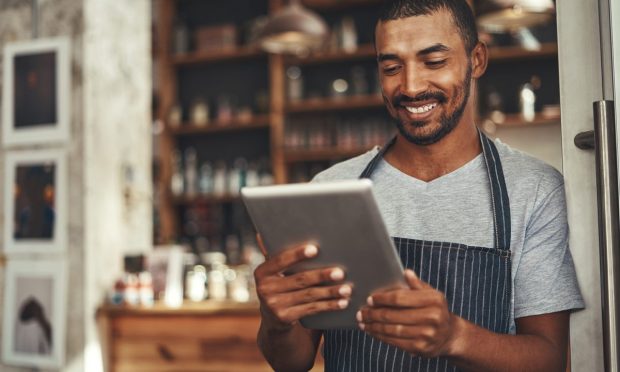Toast President Says Ghost Kitchens No Substitute for On-Premises Dining Experience

While in 2020, digitization was necessary for restaurants to survive amid health hazards and local regulations, 2021’s ResTech innovation has been driven by restaurants’ need to meet digital and in-person demand amid severe labor challenges. To meet these needs, tech providers have been looking for ways to offer tools that automate time-intensive processes, aiming to provide an all-encompassing, integrated set of products that boosts efficiency and minimizes the amount of hands-on work required.
Restaurant software company Toast, for one, announced Tuesday (Nov. 16) the launch of new products and features, including a Toast Restaurant Card, a debit card that targets the needs of restaurant operators, as well as a couple features to simplify and optimize third-party marketplace availability and employee payment tools to streamline payroll.
“Restaurants are timeless, and the jobs that restaurants do for us — whether it’s date nights or drinks after work with friends or anniversary celebrations, and so on — these are these are all things that aren’t going away,” Steve Fredette, president and co-founder of Toast, told PYMNTS in an interview. “But I think technology will increasingly just enhance those experiences, and there’s going to be a lot of change in the next five and 10 years … It’s an exciting time to be in the restaurant technology space.”
Certainly, even with the rise in digital ordering, on-premises dining continues to account for a large share of total restaurant orders. According to PYMNTS data from the Restaurant Readiness Index, created in collaboration with Paytronix, about one-third of restaurants’ total sales currently come from on-premises dining, encompassing both dining room and outdoor seating. That portion goes up to 36% for chain full-service restaurants (FSRs) and to 40% for independent FSRs. Additionally, the study found that the majority of restaurants (61%) report that their sales generated in person remain about the same as or greater than their 2019 revenues.
Read more: QSRs’ Lagging Loyalty-Reward Investment Hurts Innovation and Sales
Giving up the Ghost
Given the importance of the dine-in experience, Fredette is not sure whether the recent ghost kitchen boom, with many large restaurant brands announcing major partnerships to launch hundreds of new locations, will prove prudent in the long run.
“You could look at meal kits as an example, where a lot of companies had a quick rise and success and then faltered,” he said, “and so there’s a good question, with ghost kitchens or cloud kitchens, of how important are they going to be in the long term.”
Granted, for all the endurance of dine-in, digital ordering is certainly on the rise. According to data from PYMNTS’ How We Eat Playbook, created in collaboration with Carat, from Fiserv, which features a census-balanced survey of more than 5,200 U.S. adults, consumers now are 31% more likely to buy meals to be eaten at home than they are to dine on-site, and 43% of consumers are now ordering online for delivery more often than they were prior to the start of the pandemic.
See also: Up for Grabs: Restaurants and Grocers See Path to Picking up 200 Million New Customers
That said, it is still too soon to say how consumers’ mid-pandemic behavioral changes will ultimately impact their long-term ordering behavior, and Fredette is not sure whether these ghost kitchens solve a large enough need for consumers to support their rapid proliferation.
“I think it’s easy to jump on some of those bandwagons early but then find it’s not the right thing,” he said. “If it’s just a trend for trends’ sake, I’m not sure it’s going to be sticky if it’s not solving a long-term customer need.”
Restaurant Payments of the Future
“There’s certainly a lot of discussions about what the future of work looks like,” Fredette said. “The pandemic has caused the great resignation … that hits every industry, including the restaurant industry, and so I think flexibility is important.”
One place where this flexibility is most necessary is in payments, he said, as different legislatures’ regulations on currencies require constant adaptation and as the rise of and pushback to cryptocurrencies precipitate rapid changes in how money changes hands.
“Ultimately, the restaurants, as merchants in that equation, have a big part in that,” he said, “[Toast is] continuing to help take the trends that are happening in the FinTech world, to apply them to the restaurant industry and directly help our customers to get those benefits.”
He added that restaurants need more flexibility in accepting digital orders as well, with the proliferation of different third-party marketplaces having turned many restaurants into “tablet farms” wherein consolidating orders from different platforms becomes its own labor-intensive task.
Tools such as Toast’s and those that other ResTech providers have been launching in recent months that streamline the process make it possible for restaurants to maintain this omnichannel availability without sinking much additional labor into order management.
Related news: Growth of Ghost Kitchens Threatened by Outdated Digital Payment Tech
The Last Five Years
Fredette recalled that, where once change in the restaurant industry took decades, the timeline has sped up, due not just to the obvious pandemic-related concerns, but also to a period of innovation in the late 2010s. He noted that adoption of handheld point of sale (POS) systems grew dramatically in the latter part of the decade, predicting a similar evolution for QR codes in the years ahead, forecasting that, with the exception of fine dining, own-device payments will become the norm.
“I think that’s a good window into how much change can happen in just five years,” he said. “So, if I look at Order & Pay, scanning the QR code on the table, or just getting the QR code on the receipt, I think that has the potential to follow that same trajectory as the Toast Go [handheld devices], where in five years from now, that’s just going to be the normal way we eat.”
